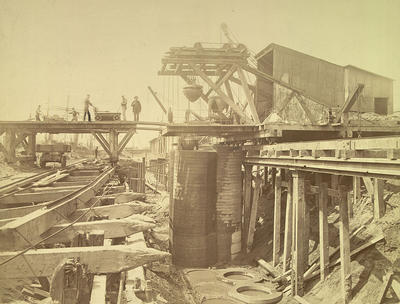
A photograph showing a cylinder group being sunk to form the foundation of the riverside quay wall of Queen's Dock, June 1878. This method of construction was adopted when conventional wooden pile foundations were inappropriate in silt or soft ground
The cylinders were made from concrete rings formed on the site and then lowered into trenches excavated to about 4 feet below water level. When a group of rings had been built up to 28 feet it was sunk into the ground by way of excavation from the centre of each cylinder using the excavating machinery which can be seen hanging from the structure above. To aid this process 300-400 hundred tons of cast iron weights were placed onto the cylinders, as also shown in the photograph. Once the bottom of the cylinder had been sunk to the intended 50 feet below quay level, its hollow centre was filled with concrete and sand, and the quay wall was built on top.
The cylinders in the foreground of this view have already been sunk in position and filled.
Reference: T-CN 19/61/2
Reproduced with the permission of Glasgow City Council, Libraries Information and Learning
Keywords:
cast iron weights, civil engineering, concrete cylinder rings, construction sites, docks, foundations, labourers, navvies, quays, Queen's Dock, site railways
You have 0 images in your photo album.